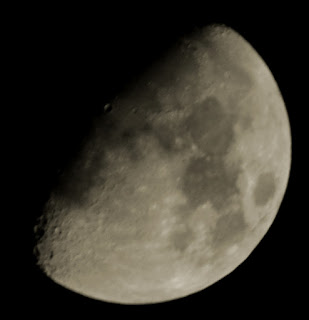January 31st 0120 GMT Moon
There was a brief clear patch of sky and I was able to snap the waning gibbous moon at 300mm focal length, ISO 100 and 1/320 second exposure.
January 23rd 1050 GMT Sun and Moon
Using the same technique of the day before. I snapped the Sun in hydrogen alpha light and caught more detail.
I tried the Moon at 55mm focal length but when I switched to my other lens, I went at 300mm, ISO 100 and 1/250 second exposure. It was one of the best daytime lunar photos I had ever taken.
January 22nd 2250 GMT Moon
I could not resist another lunar shot.
January 22nd 1825 GMT Moon
Mid and late afternoon were full of heavy rain showers but it cleared again later to give me a second attempt at the Moon, in full darkness. I used my DSLR at 300mm focal length, ISO 100 and 1/200 second exposure.
January 22nd 1320 GMT Sun and Moon
Not trusting my back 100%. I took my Skywatcher Startravel 80 out for some overdue exercise! I used a 32mm Plossl eyepiece to deliver 12.5 x magnification. I achieved a sharp focus and saw one small sunspot. I made a drawing from this observation.
Next I took out my Coronado PST at about 26x magnification
and saw some albedo features on the Sun. I took some afocal shots on automatic
settings.
As the Moon was up, I had a go with my DSLR at 300mm focal length, ISO 400 and 1/200 second exposure. Unfortunately, I could not get enough contrast, so no useful images.
Finally, came a go at the Sun at 300mm focal length, ISO 100 and 1/4000 second exposure.January 22nd 0025 GMT Betelguese
I noticed another patch of clear sky. Betelguese was visible, with Pollux, Aldebaran and Procyon. Betelguese appeared to be about magnitude 0.6. This tallied with brightness estimates I made earlier in the month, suggesting that my estimate in poor conditions was an anomaly.
January 21st 2125 GMT Moon
I had a rare patch of clear sky. Although many stars were visible, the Moon was just past first quarter, so constellation and deep sky photography was out. Fortunately, Mars was close to the Moon, so my aim was to get the two together.
First I caught the Moon at 300mm focal length, ISO 100 and 1/500 second exposure.
Unfortunately, the conjunction shots and Mars shots did not work and neither did the Mars shots. The latter was not a surprise because Mars was too far from Earth for observation in small telescopes. There was no second chance, as cloud rolled in.
January 17th 0130 GMT Betelguese
I noticed a small patch of clear sky. Normally, this would pass without comment but Betelguese was visible, with Pollux and Procyon. Aldebaran was clouded out. Betelguese appeared to be about magnitude 0.5, although Procyon (magnitude 0.38) could have been affected by a thin layer of cloud. However, the indications (to date) were that Betelguese was within its normal range of brightness and could have been brightening slightly.
January 6th 2045 GMT Betelguese
The sky was misty. I had a look at Betelguese and estimated its magnitude at 0.6, slightly brighter than my previous estimate. It may not have been a genuine increase in brightness but could have been due to different viewing conditions on the days concerned.
January 5th 0750 GMT Moon
The repeat performance the morning after did not work so well.
January 4th 0740 GMT Moon
Clear skies were not frequent in the first week of January but I caught the Moon through a gap in the cloud with my Mak and DSLR at 300mm focal length, ISO 100 and 1/500 second exposure.
January 1st 0325 GMT Moon
It was not our original plan to stay up that late but we had been watching TV until 0230 GMT. I thought we could stay up a bit longer and chat to my wife's family, as they saw in the new year in Chile. It was great to see them, even on a computer screen. The, of, course, there was the Moon. It was well below zero, so I did not take a telescope out and used my DSLR instead. I used it at 300mm focal length, ISO 100 and 1/1000 second exposure.












No comments:
Post a Comment